postmaster@museumofanthropocenetechnology.org, via Leggiuno 32
2014 Laveno Mombello
Italia
Report on a collaboration between an artist, a creative developer and a scientist.
The Scientist in Residence Programme (SIRP) of GLUON (BE) was foreseen to be a two years project.
In my case, the residence with artist Jan De Cock started immediately on the evening when SIRP was launched at Ars Electronica 2017, and ended with a lot of loose ends at AE 2019.
This report gives brief answers to questions posed by GLUON. Being short, they miss a lot of the color and charm, frustration and joy of the collaboration with Jan, David and the people of GLUON. They miss what, at the end, made me look differently at both art and science. In an Appendix, I therefore also try to tell my version of the full story of my “residence”.
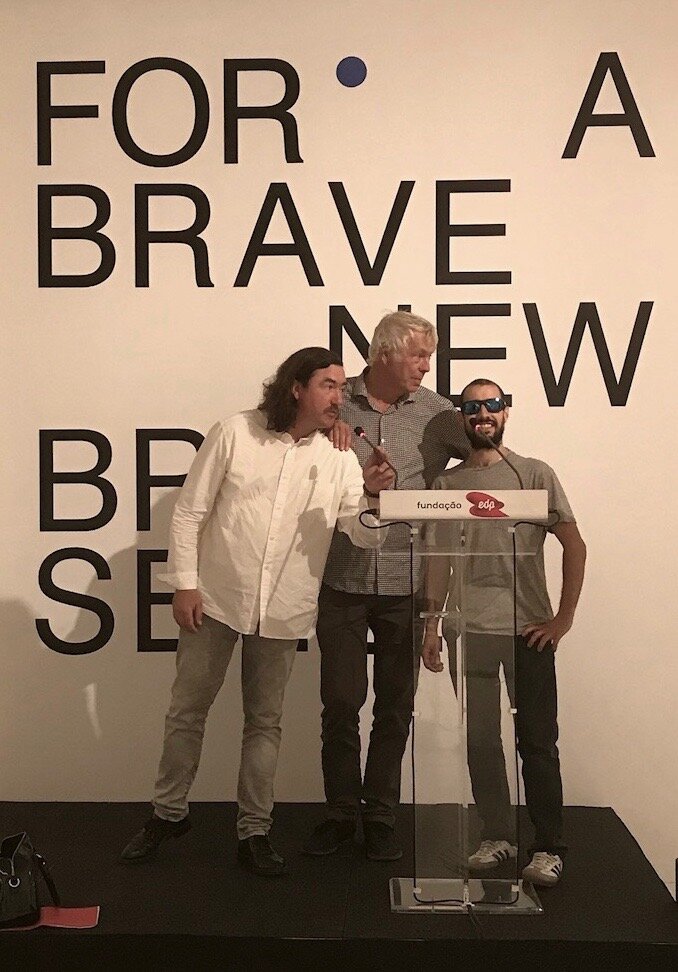
The actors, from left to right: Jan, myself and David in Lisbon.
The actors, from left to right: Jan, myself and David in Lisbon.
Short answers to GLUON’s questions
To what extent can these interdisciplinary collaborations stimulate innovative ideas and projects?
A lot! Interdisciplinarity, which necessarily includes “looking outside the box”, has always been a major way to expand individual disciplines, whether they are art, science, philosophy, …
What challenges have you faced as a researcher in your collaboration with an artist?
My main challenge had nothing to do with art or science, but with tuning into the personalities of my partners. I am sure they had the same problem with me! Jan, David and me, resp. 44, 32 and 64 years old, were/are indeed seeing and living the world in very different ways.
When dealing with the “two cultures problem", what solution have you tried to implement?
I personally see more similarities between art and science than differences. I hoped to start from the similarities: our common interests, our common aspirations, common problems, etc. to come to a common result. But that turned out to be impossible. Jan, was the “master-sculptor” and I had to be his “Noble prize winning scientist” (his words!). So, I accepted to start from what made us different. It is of course nice to stress differences, to highlight what makes us unique. However, if one really wants to meet and work together, there is a limit to how much you can stress these differences. It was in fact fascinating to hover close to that limit.
How can organizations help artists and scientists to achieve meaningful exchange?
They can certainly help by creating a spatial, temporal, intelectual and financial environment to bring us together. Being together in all these dimensions is fundamental. You can impossibly do this through emails.
How did this experience alongside an artist allow you to rethink your own role as a scientist?
I had already been rethinking my role as a scientist and what to do with my interests in art and education. I have been experimenting in a variety of ways with mixing art, science and politics. The SIRP project gave me the opportunity to know a few artists a bit better, Jan in particular, but also Annemarie, Frederik, Maarten, ….I had the opportunity to look and listen to them. These contacts confirmed that there are other ways of “thinking things through”. In physics, after the initial intuition, the “thinking things through“ quickly becomes using logic and mathematical derivations. Artists do it differently, I witnessed: it’s more thinking by doing. My contacts with the artists broadened the band-with of my thinking and doing. That was in fact needed. I am presently spending quite some time in giving talks about the climate change problem. Creating the right perception of the problem and of the urgency to do something about it needs indeed something more than just logic and mathematics.
To what extent can you compare artistic practice and scientific research practice?
I would go a long way with others (e.g. Bruno Latour) claiming that the differences between art and science are a theoretical invention of modern thought. In practice artists and scientists do the same work most of the time: they have to discuss with colleagues, set up collaborations, develop expertise, master techniques, experiment, deal with doubts, handle competition, look for support and money and a place to work, spend time in train stations. It is only at the moment of presenting the result of that messy work that we start rationalizing and “purifying” the work, calling it an “art work” or a “scientific result” and telling the world that it is the result of “artistic practice” or “scientific methodology”. All this was more or less confirmed by this project.
Appendix: the story of an exercise in collaboration
The actors
The scientist (= a theoretical character invented by Modernity)
Let start with myself, if I may. I studied physics and became a climatologist, I did research in the laboratory, made model calculations, went to scientific conferences, etc. and made my money in doing so. So I am a scientist. (*A simple answer to what is a scientist or what is an artist, is indeed: somebody who makes a living by doing what is considered to be scientific or artistic practice.)
However, I need to add three qualifiers. (* Many scientist will have a qualified answer when asked: “Are you a scientist?”: proof that the “pure” scientist is hard to find. The same for artists, I guess)
First, I am a scientist who has worked for the past thirty years for a policy making organization which is the European Commission. I have been responsible for climate change research at the EC’s Joint Research Centre (JRC). We do not do fundamental research like at universities or Max Planck institutes. We do applied research in the sense that our output should be facts and figures that can be used by our colleagues policy makers in Brussels, e.g. when they negotiate new European legislation with national governments, industries, NGO’s , etc. …. So, apart from doing our scientific research some of us also had to talk constantly with our colleagues non-scientists and some of these “some of us” were not shy to include theatrical, not to say artistic elements in their talks to make the scientific message more clear.
That brings me to the second qualifier: I do not believe too much in this separation between science and art: we should not exaggerate this. I truly believe that there are more similarities between science and art than there are differences. It is with scientists and artists like with, e.g., black and white people: the difference between two white or two black people will often be bigger than the difference between the average white and the average black. But I also realize how we like to exalt the differences, the things that set us apart from the others and make us unique.
The third qualifier is that nearly 4 years ago, I left the European Commission and let its Joint Research Centre slowly retire from my life. I am now no longer in charge of people or programmes in the JRC. I let this happen in order to be able and dedicate more time to education and the arts. I wanted to tap also into the aesthetical relations between things, and not just the logical ones. I needed time for that. So what I learned through SIRP will not immediately feed back to research practice at the JRC, but I hope somehow it will, at the JRC or elsewhere.
The artist (= a theoretical character invented by Modernity)
I met him for the first time at the SIRP meeting in 2017. His name sounded familiar. By the end of the meeting I remembered and I could ask him: “Are you the Jan De Cock who exhibited at MOMA?” “Yes, sir!” he said with a twinkle in his eyes. “I have seen that exhibition! By chance, but I’ve seen it!”.
From Wikipedia:
“Jan De Cock is a contemporary
visual artist. From the start of his career, his art has revolved around production and the ways in which an artist relates to the broad culturally-injected concept of Modernism. In 2003 Jan De Cock entered the competition Prix de la Jeune Peinture Belge (Prize for Young Belgian Painters). He is, after
, only the second Belgian
artist to have had a solo exposition at Tate Modern and the first living Belgian artist to have an exhibition at MoMA, which opened on 23 January 2008. Much of his work appears to draw visual and formal comparisons between early-20th century abstract art movements (such as Constructivism, Cubism, and Suprematism) and contemporary design and mass production. Additionally, de Cock commonly includes a performative element intended to act as social critique or to place his work demonstrably into a system of exchange.”
I somehow liked the artistic works of Jan, especially his more architectural interventions. They reminded me of the Memphis movement in Milano, early 1980ies. Memphis had never put their works in contrast with classical art. I found Jan’s installations within the architecture of 19th century museums where they dialogued with classical and romantic paintings very beautiful.
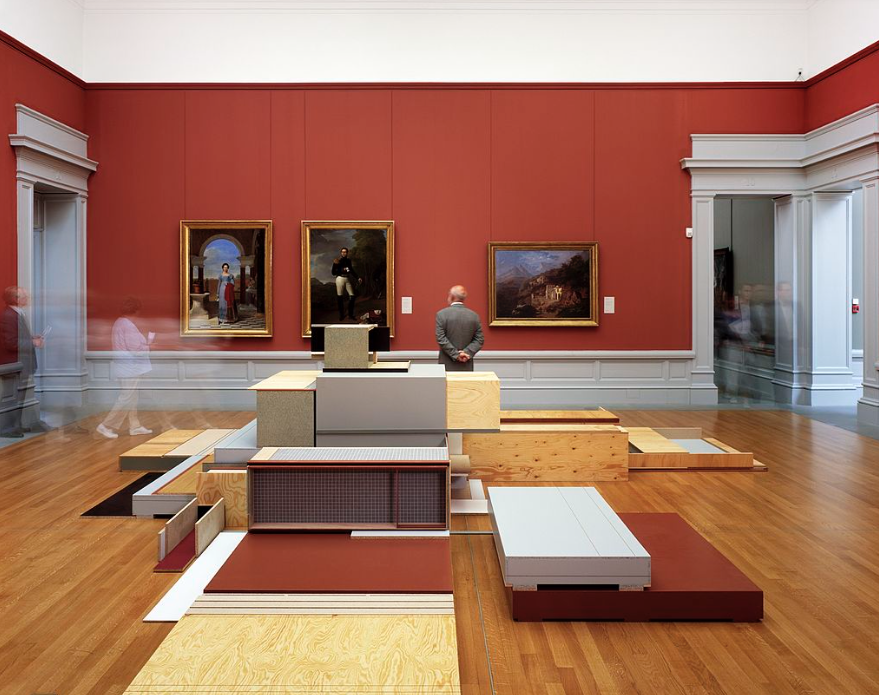
Work by Jan at the Museum of Fine Arts, Ghent, 2002.
Work by Jan at the Museum of Fine Arts, Ghent, 2002.
The creative web developer (= invention of current days)
David Surprenant joined the project a bit later and will be introduced in due time.
Art and science: similarities (?) and differences (?)
Let’s come back to similarities and differences between artists and scientists and how they could be used to set up collaborations between them.
It looks straightforward, at least to me, that artist and scientists could easily work together if they admitted that for most of their time, they do similar work. So why not join forces? I tried to suggest that as a way of working with Jan De Cock. I suggested that we could start and reflect about our common practical conditions that determined a lot of or work. Namely, that we were both from the same small country (Belgium) but working internationally, that we both had to deal with “the Italians” in particular, that we could not fulfil our dreams alone, but that we needed to create a group or a school, that we both wanted to create a museum, an architecture, bigger than ourselves, etc. …
But it was quickly clear that this approach wouldn’t work. Jan saw himself as the artist, the master sculptor, part of an elite. Although he theorized about “communistic sculpture” he was no partner for engaging in an egalitarian way of working with me or with anybody else. In this project, he and only he was the artist and I was the scientist.
I was willing to accept this. Hence, we would approach this collaboration starting from our differences, and not from what we shared.
Artists and scientists, who think of themselves as different people, can only really collaborate in new areas that are not yet claimed by either the arts or the sciences. Areas in which neither the artists nor the scientists know how to go about things: everything is still open, and a brainstorming between different disciplines could still open a way forward in either a scientific or artistic direction or maybe in a third direction. (* In fact, GLUON must have thought the same. In the beginning of SIRP, the call was for scientist from new areas such as exo-meteorology, astrobiology, neurology, but also from old but rather enigmatic disciplines like quantum physics or mathematics).
If Jan and I would collaborate starting from our differences, what in climate science was sufficiently new that it could be tackled with scientists and artists together? What could Jan and I come up with, that neither of us could do alone?
In my opinion, that new thing was not to be sought in the physics or chemistry or biology describing the climate system. There the science knows what to do and there is very little that an artist can contribute to open new insights. The new things are to be found in psychology, sociology, anthropology or politics around the question: do humans really care about climate change? And, one step further: do humans care about humanity? And if we do care, do we care enough that eventually something will be done about it: a different lifestyle, political engagement, a new culture?
These are still questions for which neither art nor science has an answer. It can most probably be tackled together, I believe. In fact, it is a believe that grew stronger during the project, through the interaction with the artist and GLUON.
Linz Sept 2017
The first SIRP meeting took place on an evening during the Ars Electronic festival in 2017. A group of invited scientists and artists, presented themselves to one another. Artists would subsequently select the scientist they wanted to collaborate with. I did a presentation about the complexity of the climate system, feedbacks, etc. I kept it rather scientific.
In don’t know how, but after that meeting and the reception that followed, I found myself alone with Jan in the meeting room. That room was in the basement of an enormous building which had been a postal distribution centre: a huge material-mechanical model of the internet. It is a building in which you get lost during daytime, so you can imagine during early night time when some doors had already been closed and some lights been switched of. Jan and I wandered for half an hour through hallways, staircases, past machinery, tubes, slideways, with here and there a flickering art installation lurking at us. Eventually we could crawl out of the building through a conduct of post bags, like post bags indeed.
We made it, together, Jan and me, Jan and the scientist who had seen his exhibition in MOMA, and it felt like, as they say in the movies: “the beginning of a beautiful friendship”.
We jumped in a taxi. The driver was a black man: “from Gabon”, he said.
“Incredible”, Jan replied “we are on our way to a meeting with the minister of culture of your country. We want to be in time!”
That same evening we drank wine with the people of GLUON, and without the minister of Gabon. Jan announced that he would work with me and make an App to tackle climate change: a kind of a device that Volkswagen had used to cheat emission checks on its cars, but working in the opposite way. That was not a bad start! I had to admit, however, that I didn’t know anything about Apps. That surprised Jan, which didn’t surprise me: in contacts with other artists I already learned that some of them would consider scientists as people who would solve their technical problems. GLUON stepped in and provided us with a creative developer, David Surprenant, a young Canadian guy who would help us with, a.o., the technical aspects of App development. GLUON was very keen to have Artificial Intelligence as part of our project: that is what its sponsors were asking.
Mombello April 2018
I was the scientist in residence with Jan, but Jan was the first to visit me.
He wanted to visit the Joint Research Centre, he needed to do a Skype conference speaking to students of the University of Hasselt, he wanted to see my Museum of Anthropocene Technology, all in an afternoon. But we started with having coffee.
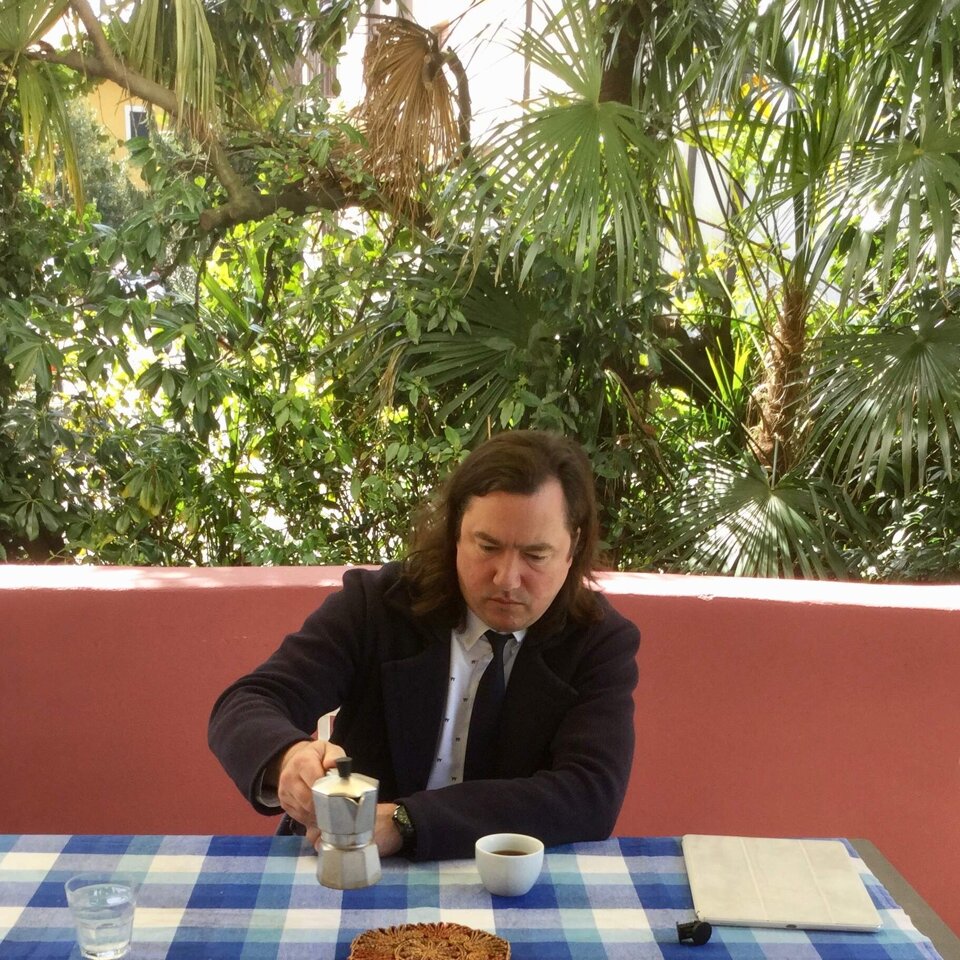
Jan "in residence" at my place in Laveno Mombello
Jan "in residence" at my place in Laveno Mombello
The meeting to the JRC was postponed. My living room house was transformed in a studio for the video conference, in which I was also drawn into and presented as … a Noble prize winning scientist. We went to the Museum where I just had had an exhibition together with a friend. Jan looked around and concluded “Frankie, that is not very good”, and without asking he started rearranging the works into totems. The result was, well: breathtaking. In a few movements Jan showed what it meant to see things through and bring them further than what I had ever been able to see.
“I am perplexed”, I said, ”you lifted the works out of the anecdotical. These totems are simply beautiful”. “The matière premiere was also good”, Jan generously added.
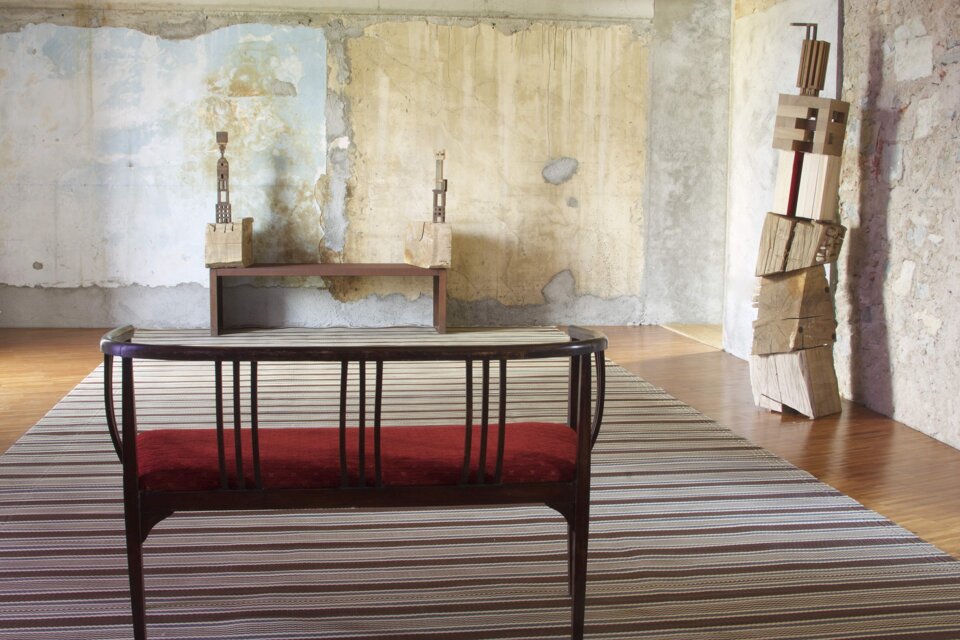
An installation at the Museum of Anthropocene Technology, after Jan’s intervention
An installation at the Museum of Anthropocene Technology, after Jan’s intervention
The afternoon had passed in a minute. We hadn’t spoken about the App or climate change but we arranged for a meeting in his new studio near Ivrea,
(* I think that one of the reasons, there were a few, that Jan choosed to work with me was that he was moving out of his Brussels Art Institute and into a new studio near Ivrea. Jan compared the move to those of the Early Flemish painters that crossed the Alps to work in Italy. “I am the Rogier Van der Weyden of present times!” he would later say on Flemish Television. Anyway, it would have been handy for him to work with somebody who lived in Italy, not so far away from Ivrea.)
Ivrea May 2018
A month later I visited Jan’s studio. The studio is a villa on top of a small mountain near Ivrea. “Villa” must not be understood as in “a villa in Knokke-le-Zoute”, but rather as in “villa Borghesi in Rome” or as in “villa Taranto at the Lake Maggiore”: hence a huge building with distinct architectural qualities. When I arrived at the villa, Jan was sitting on a bulldozer, taking out trees and laying bare the rock on which the villa was built. He was sculpting the landscape. This was his “Mountain of Resistance”, resistance against changes in the world that he didn’t like but that he did not explain further. Jan had taken all windows out of the building, so that we could see the long slope of the moraine at the other side of the valley through the building. We entered the villa. I was the first to see it, I could not take photographs.
In the main room at the ground floor, workers were taken out the parquet floor. “This is pure oak!”, I remarked, but Jan didn’t seem to care. While walking up and down through the huge building, the landscape around the villa was presented in hundred different ways through the window openings: from the trees nearby to the hills far away. The building was a tool for Man to look at Nature. Jan talked about his plans for an art school, a foundation, a gallery. Outside again, we walked over the rock and I explained him how his rock, and in fact the whole landscape around, had be sculpted by the Mont Blanc glacier. During the past 2 Million years that glacier had been moving ten times in and out, during ice-ages and inter-glacials respectively. I pointed at the rock: “this is a scar you made with your bulldozer, this is a scar made hundred thousands of years ago by a pebble crushed by 3 km of ice." Jan was listening carefully. It was clear that this was his first lesson in climatology: his first exposure to the long time scales involved in natural climatic changes.
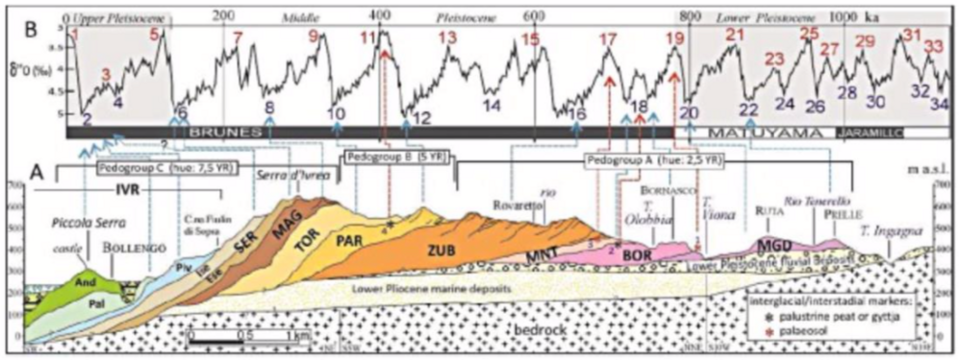
Cross section of the valley near Ivrea. It shows the various layers of material in the moraine, as they were pushed up by the Mont Blanc glacier during recurrent ice ages in the past 2 million years.
We had lunch in a little castle at the other side of the valley, during which I was drawn in a negotiation between Jan and the owners about a possible overtake of the castle. I understood there was a Russian businessman who offered three times more than what Jan could offer. Jan continued with all sorts of arguments to explain why the owners should anyway sell their castle to him. At the same time, he was criticizing them for how badly they had arranged the garden around the castle, for how the butler had served him wine. The owners, a couple in their seventies, started to look helplessly to me. I said: ”Jan has his style, I know, it is the straightforward style of us people in the North. But I believe he has a good plan”. The negotiations ended inconclusively.
After that and before leaving Ivrea, we had a coffee in a bar. I told Jan that with “our” straightforward style it would be difficult to have something done with “the Italians”. Jan listened and stared in front of him.
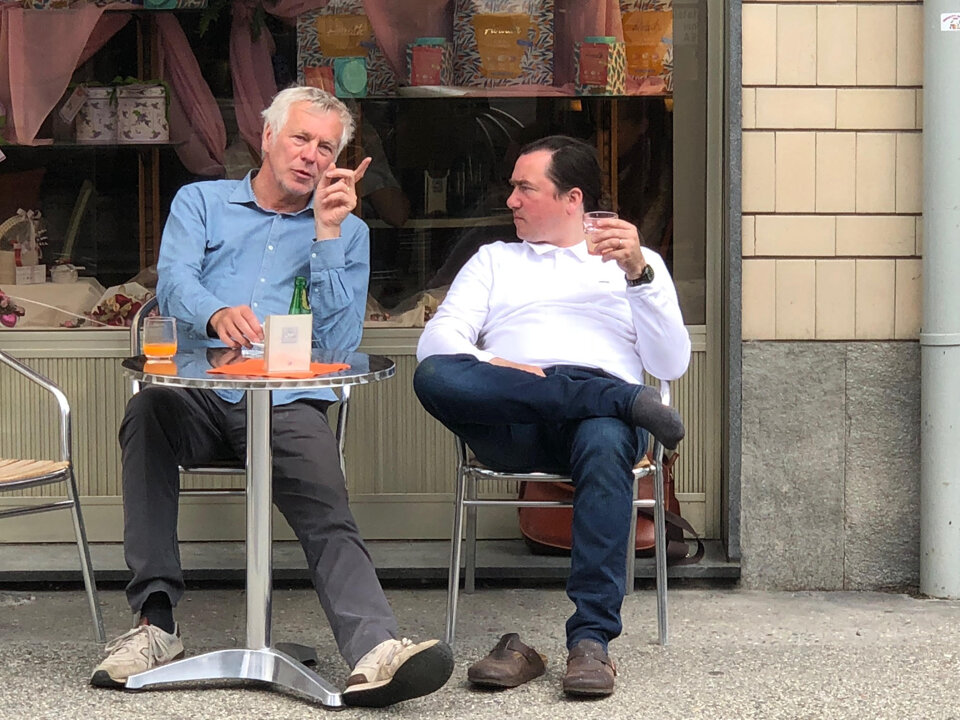
How to approach the Italians: discussing our northern straightforward style at a bar in Ivrea
How to approach the Italians: discussing our northern straightforward style at a bar in Ivrea
Anyway, we also talked about climate. The inter-glacial that we are presently living in started about 10.000 years ago and would come to an end only 20 – 30.000 years from now. At that time the Earth would slide again into an ice age, with the Mont Blanc Glacier again moving over Ivrea and 3 km of ice over Jan’s villa. Jan listened and turned the idea of the App into a sort of transitor radio with which we would resist the coming ice age. The “Resistance Transitor RT.” was born. At least we had a name.
Back at home, I reflected on our discussions and I felt a bit uneasy that we would focus on the long time scales and the coming of an “apocalyptic” new ice age 20 – 30.000 years from now, while we were heading to a possible disaster in the next 100 years. We needed to do something with both the long and the short timescales involved in climate change. That was interesting, I thought
Brussels July 2018
The whole team met in the Brussels Art Institute (BAI) of Jan. That means Jan, Christophe, GLUON director, Lise, a young and smart art historian, assistant to Christophe, “David Canadian”, as Jan called David, and me.
Jan and I travelled together from Milano to Brussels for that meeting.
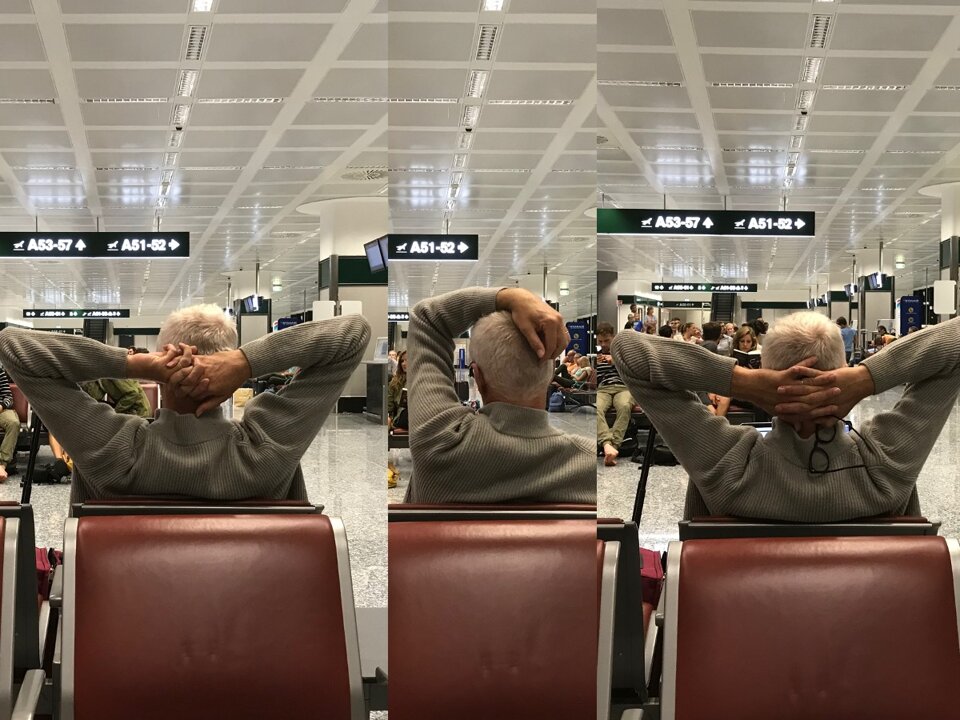
Around midnight, waiting in Malpensa airport with several hours of delay. Photo's by Jan.
Around midnight, waiting in Malpensa airport with several hours of delay. Photo's by Jan.
We talked about life in Italy. About how he could visit the Mont Blanc Glacier. I said that he had to hurry because it was predicted that all glaciers below 3500 m would melt before the end of the century. There was a brand new futuristic cable car that the Italians had built at their side of the mountain. “How do you build such a thing?”, Jan asked. “Well, they started with a very small wooden cabin 100 years ago, using mules to bring up the stuff. Then a bigger one in stone 50 years later, using the first as a base camp. And finally, the last one in glass and steel, using the stone one as the base camp”. ”Can we organize an expedition with mules to attract attention to the shrinking glaciers?” Jan wondered. (* With hindsight, I think that such an expedition, with Jan sitting on a mule and his scientist walking besides them, might have been something!)
These were the last days of the Brussels Art Institute. Jan had sold the place in order to move to Italy. It still showed the interventions that he had made: furniture, desks, walls in lacquered plywood. I liked it: even more Memphis than what I had seen before.
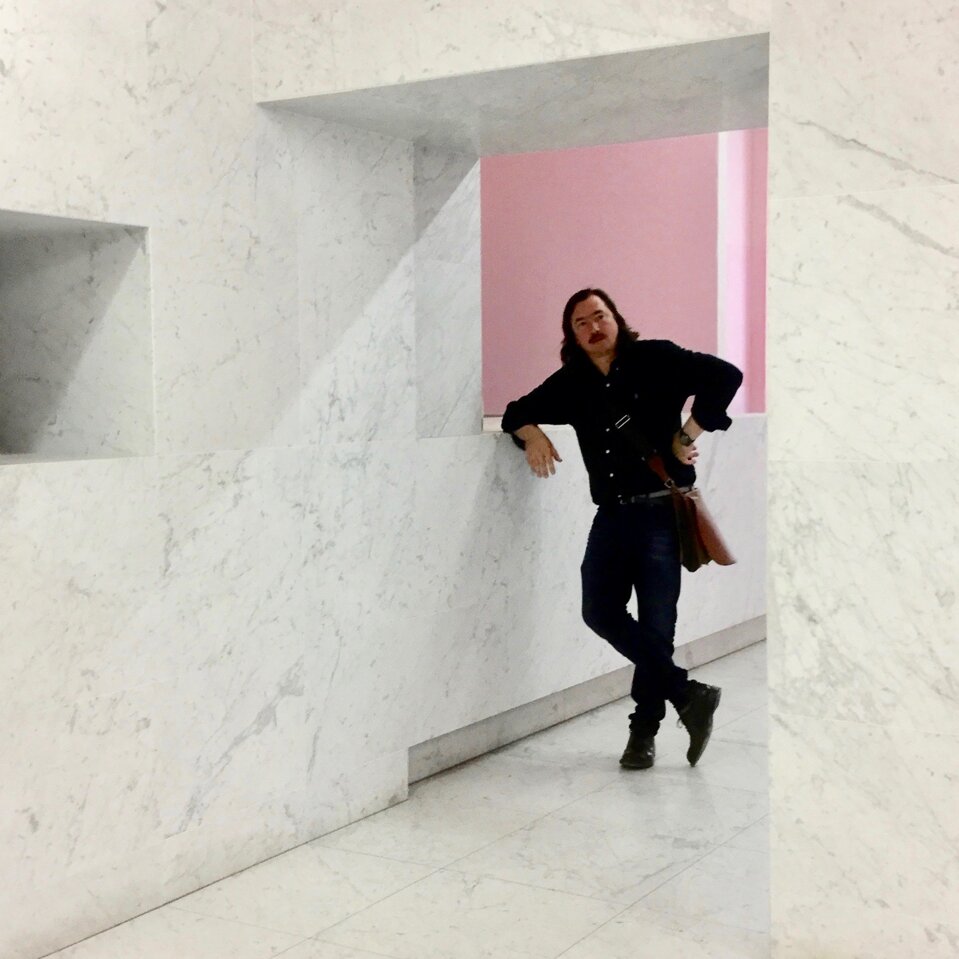
Jan in his Brussels Art Institute, just before leaving it for good.
Jan in his Brussels Art Institute, just before leaving it for good.
Anyway. In Brussels we had an intense exchange of ideas.
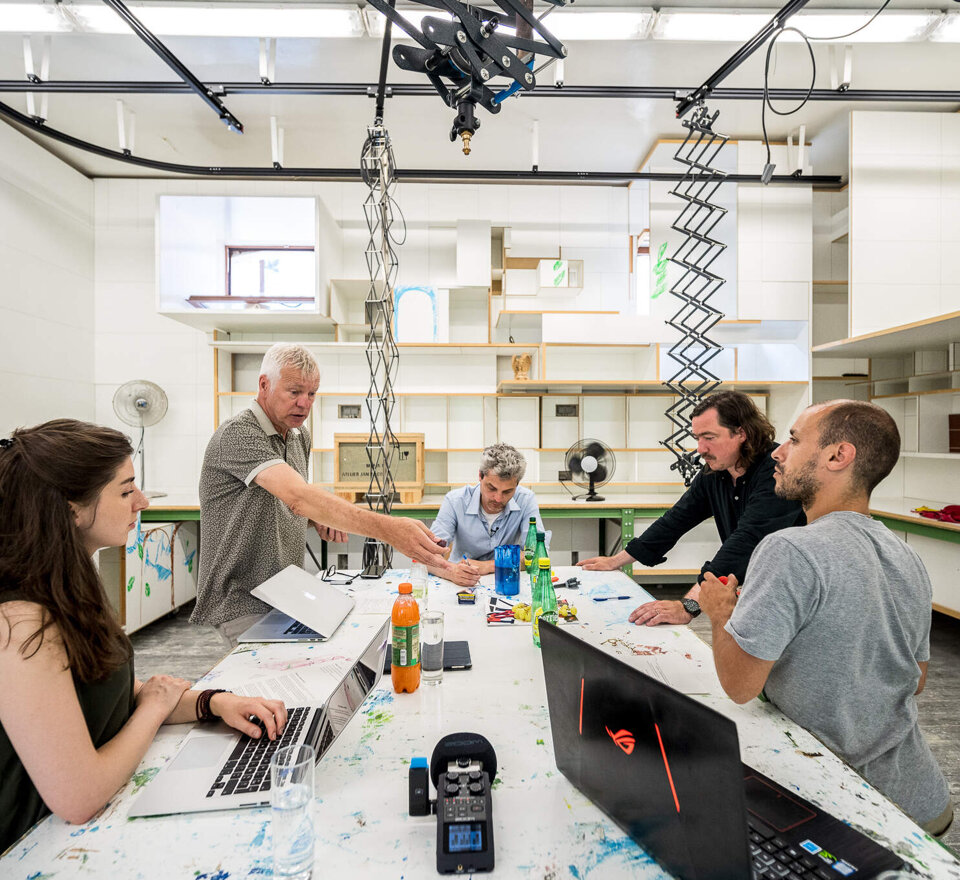
The complete team discussing: Lise, myself, Christophe, Jan and David.
The complete team discussing: Lise, myself, Christophe, Jan and David.
In an email to the team, I summarized our discussion as follows:
As far as I understood, but I am not quite sure, we will make a gadget, called the Resistor Transistor, that
-people visibly wear
-tells that these people care for the planet and its inhabitants; human and non-human
-aims at collecting and sharing information that helps controlling climate change
-registers people’s doings that most contribute to their personal CO2 emissions
-shows (e.g. with a red or green light, or a sound) how far they are off their allowed CO2 emissions.
-makes every one of these people a leader
-shows the impacts of going above the allowed CO2 emissions based on input from locals (**). Such impacts could the melting of glaciers, reduced agriculture, increasing floods, …
In further written exchanges, I tried to give only scientific input: data and graphs, with the hope that they could somehow inspire Jan. I didn’t expect him to understand all these data, but to me some of these scientific graphs had a beauty on their own.
I also tried for myself to interpret what Jan had come up with so far: glean something from the stream of ideas that Jan created when we were together (and probably only when we were together…).
Ivrea August 2018
We all met again in Ivrea in Jan’s villa and surroundings. Jan had set us up in a most beautiful hotel, an old perfectly restored castle of which there are many in the Piemonte area. We had dinner in what was called: “the royal room” with frescoes of the four seasons on the vaults of the ceiling. Jan explained the story of the castle. We would talk also about art and Jan would rearrange tableware into little sculptural installations. At one moment he set a glass on top of a chandelier. I said: “I am surprised: I thought you would set it this way”, and I turned the glass on its side, to make it more look like Jan’s recent communist sculptures. Jan smiled happily. That was needed, because just before he had tried to provoke me, criticizing the work of a niece of mine who had just successfully curated a major theater festival in Belgium. He had also asked whether I was a wild pig. That last question seemed to come out of the blue, but it had probably to do with the fact that I wasn’t shaved very well. Anyway, the dinner ended in good humour and we continued talking and drinking until the early hours of the following day, underneath the gallery of one of the castle’s courtyards. Christoph tried to convince Jan that l’art pour l’art was passé and that art had to engage more with societal issues and with science and technology. Jan was not so sure. He was the Rogier Van der Weyden of present times. He belonged to an elite, and only elites do change society. Tomorrow he would show what he had in mind for his Resistance Transistor.
The following day we had lunch, shortly after breakfast, in a little restaurant along the road towards Jan’s villa. Came the moment in which Jan revealed his idea for the Resistance Transistor: it was a key hanger with a miniature alpine axe, a miniature flash light, a wine bottle, a brightly coloured scoubidou and other unidentifiable stuff. Jan wanted the technology to be built in the scoubidou. The keyhanger would be hanged around a tree or a rock in the same way people leave locks on the the Pont Neuf. Something like that.
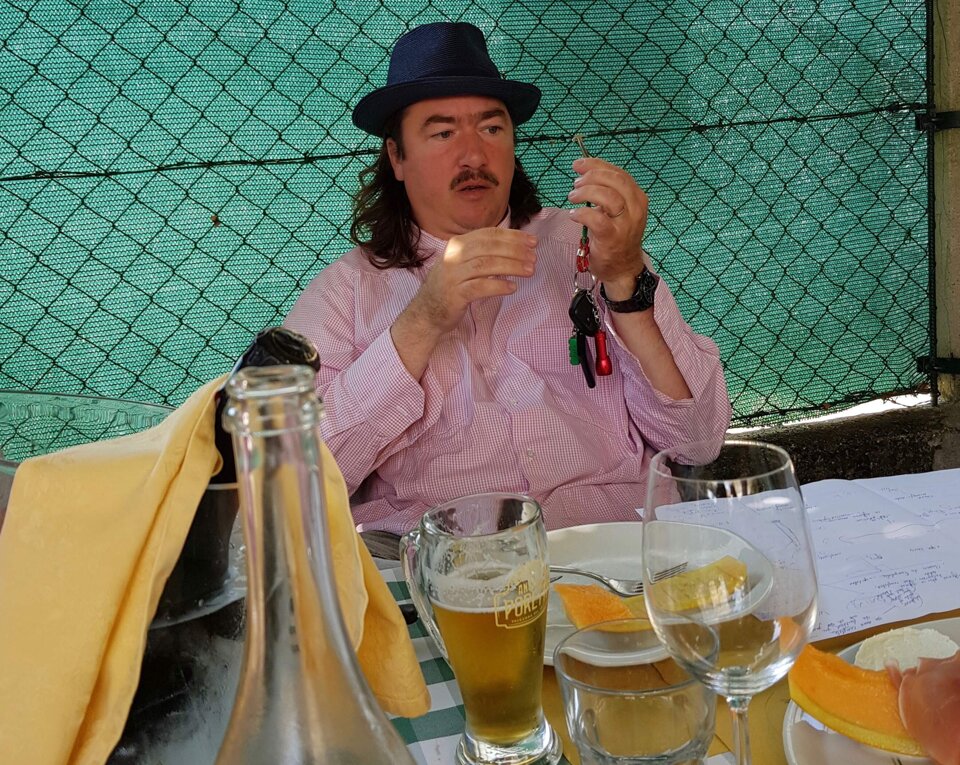
Jan reveals his Resistance Transistor.
Jan reveals his Resistance Transistor.
After lunch we first visited the villa. We parked the car on a dirt road down the hill, and walked through the woods to the top: my favorite way to approach architecture.

Approaching Jan’s villa.
Approaching Jan’s villa.
Coming out of the woods, we walked over the bare rock to discover the villa slightly hidden behind it. It was perfect scenography: the rock, the villa behind, projected against the trees and the hills.
We entered the villa. The main room on the first floor had become truly amazing. The parquet floor had been completely removed, as well as all the soil underneath so that, six meter below, the rock was again visible. The rock outside continuing inside, the fundaments on the rock continuing into the walls all the way up to the ceiling. Thàt was architecture: it really told something about Man’s claimed position in Nature.
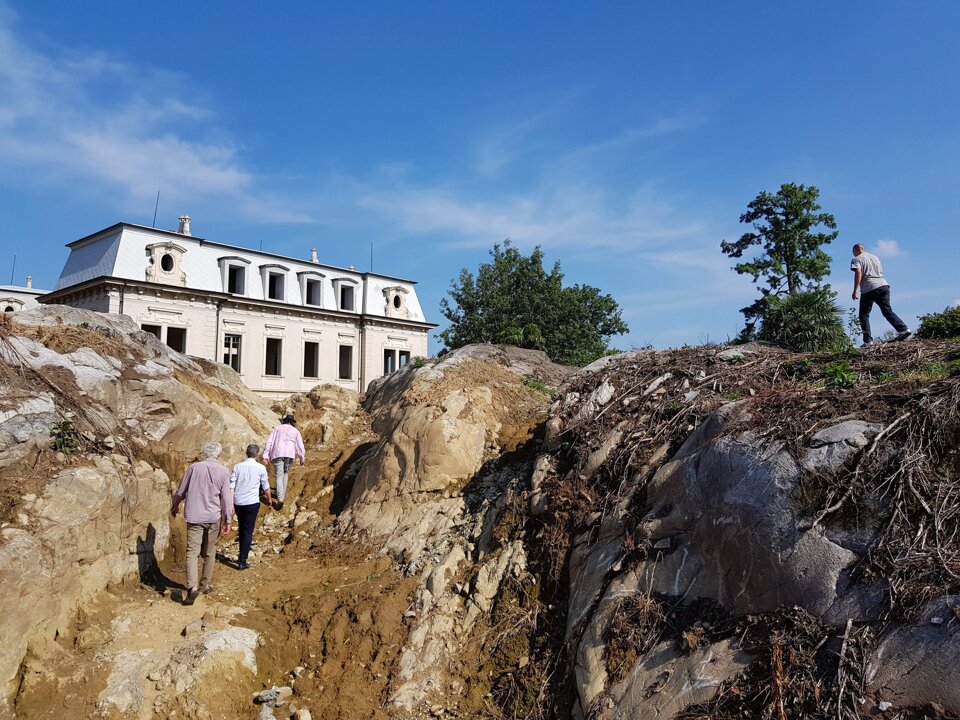
On top of Jan’s “Mountain of Resistance”, with the villa in the background.
On top of Jan’s “Mountain of Resistance”, with the villa in the background.
The next stop in the afternoon was the ruin of what was once a modern pharmaceutical factory owned by a member of the Olivetti family. It was built in the elegant modernistic style typical for many of the Olivetti factories near Ivrea. Jan said he had bought the complex. It would be the basis for his archive and his new art school. From the factory one could see his Mountain of Resistance with the villa. Jan said he needed to remove a few more trees to make it perfectly visible from where we stood. He talked about buying land so that he could connect the industrial complex and the villa with a long avenue lined with totems that would represent trees and rocks and with which the visitor would be able to communicate through the Resistance Transistor. I could sort of see what he meant. That Jan could produce great ideas was clear by now, but it all started to become a bit unreal, anyway.
Another beer before leaving and a discussion about setting up a contract for in case we would make big money … Jan was bluntly asking why I hadn’t already looked for funding with the European Commission.
I brought Christophe and LIse to Malpensa airport. Had they any idea where Jan wanted to lead the project? Did they understand the Resistance Transistor? They didn’t, neither did I. David stayed overnight at my place. We took the time to try and make sense of the tumultuous two days and how we could programme some of the ideas as an App or game.
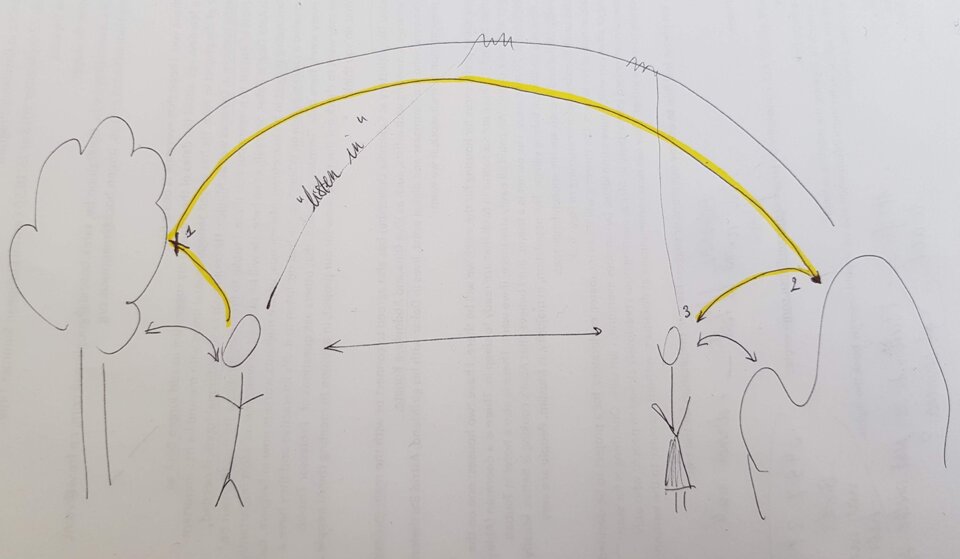
Lise’s sketch about the whole thing.
Lise’s sketch about the whole thing.
A royal intervention
Weeks later Christoph wrote us that he was curating an exhibition in Lisbon at the occasion of an official visit of the Belgian Queen and King. We had two months to show a result of our project.
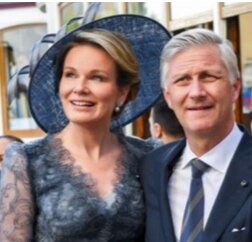
The Queen and King of the Belgians gave the project an important boost
The Queen and King of the Belgians gave the project an important boost
We didn’t have anything concrete yet. Since it was likely that the King would come and visit the exhibition, I proposed that we should do something with the climate data produced by “his” Royal Institute of Meteorology. Jan insisted that he would bring a rock and a tree to Lisbon. Rocks and trees were his business in those days, but I was happy to see it also as an intuition of Jan. Because:
for hundreds of millions of years Rocks and Trees have been controlling the climate of our Planet. They have done so by sucking up the CO2 that was spewed into the air by volcanoes and by burying it in soil and sediments. For all those years, Rocks and Trees RESISTED climatic changes making the Earth a suitable place for Life to flourish.
For the first time I could see a story that would link many of the elements that we had been discussing so far. The story continues like this:
compared to volcanoes, Humans are now emitting 100 times more CO2 into the air. They do so mainly by burning coal, oil, gas and Trees (!), which means: UNDOING the work of Trees, and by making cement, which means UNDOING the work of Rocks.
Rocks and Trees cannot cope with the fast increase in CO2 caused by these activities. They need Humans to stop using coal, oil, gas and cement, and to RESIST a change in climate that is dangerous for Humans, Trees and Rocks collectively.
So let Jan bring his rock and tree to the exhibition: David and I would program the story as a computer game and maybe the King would be the first to play with it.
Ghent August September 2018
Time to introduce David. He was, and still is, a young man in his early thirties, who was travelling around the world paying for his living by doing creative IT jobs (* Had that become the contemporary version of dish washing?). He was hanging around in Belgium in those days, jumping from one apartment to the other, from one bed to another. “That is part of the game”, he said. I went to see him a few times in Ghent where we worked on the computer game.
We focused on the past 100 years of weather data. In order to please the King, we were still very keen to talk about the weather and climate data of the Royal Meteorological Institute of Belgium. But since these data were not freely available on the internet, we had to work with the Royal Dutch Meteorological Institute. A shame for us, you can say, but it didn’t matter: the weather and climate near Brussels and near Utrecht were very much the same.
I had come up with a treatment of the temperature data that would show the daily weather variability
simultaneously
with the slower varying climate data. That might not seem a big deal, but that is actually what we are unable to do in real life: we experience the daily weather, but we do
not
experience the climate. I always thought that
that
was one of the problems with climate change: how can you care for something that you do not experience?

Treatment of 200 years of temperature data (1900 – 2100), showing weather variability and climate change simultaneously.
With our game we could try to make people more aware about how weather and climate are related, and make them care more about the climate.
David wrote a programme so that the user of the game could go back and forward in the data and realise how, despite the daily variability, climate was anyway slowly changing. David started also to transform the colours into music. So it became a piece of music with 4 voices: the soprano the high variable and capricious weather, then the tenor and alt for the months and the years and finally the bass for the climate and its slowly but steadily increasing temperature.
David was roaming the internet, downloading programs, sounds, scripts without caring for a second whether he would attract any virus on his computer. “It is part of game!” he said.
We would work for some time until we were tired. Then I would take a bicycle and David his skateboard and we would roam Ghent to find a suitable place to eat. I had been living in Ghent for many years, but I had never cycled behind a crazy guy on a skateboard zig-zagging through its busy streets. All of the sudden Ghent looked like downtown Manhattan.
Lisbon October 2018
The visit of the King was at the occasion of a trade mission of the Brussel Region to Portugal. As the president of the region said in his speech: he had taken a “bit of art in his pocket”. That little bit of art was an exhibition with 10 Brussels artists, including ourselves. Sorry, including Jan.
The exhibition was held in a most beautiful museum, MAAT, on the northern bank of the Tagus.
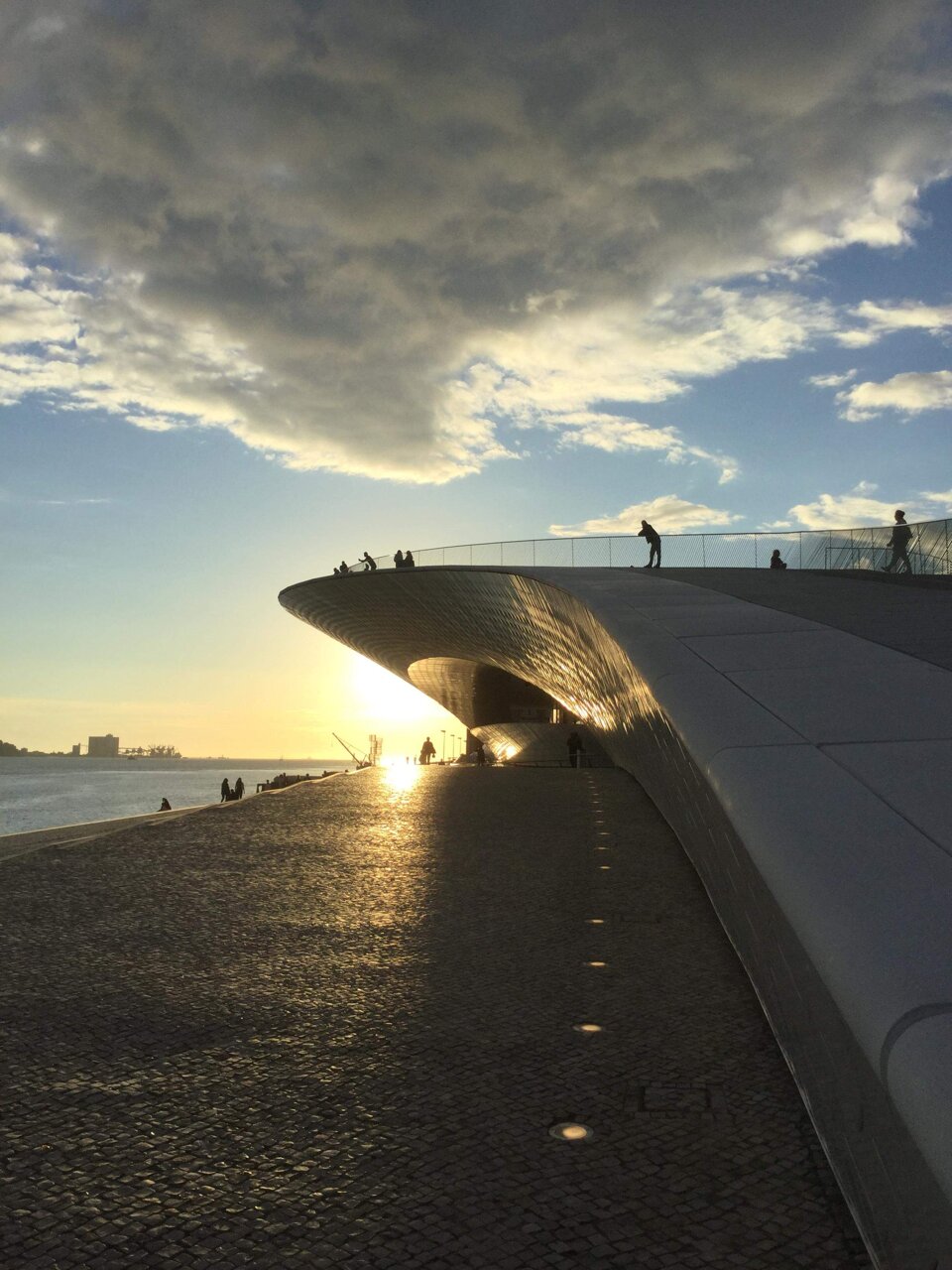
The Museum of Art Architecture and Technology (MAAT) in Lisbon.
The Museum of Art Architecture and Technology (MAAT) in Lisbon.
We had come three days before the opening to set things up. These were days not very different from a scientific conference. The artists would work in the exhibition hall, explain their work to one another, and over three days they would develop an exhibition, maybe some new understanding “out of chaos”, together with some new friendships.
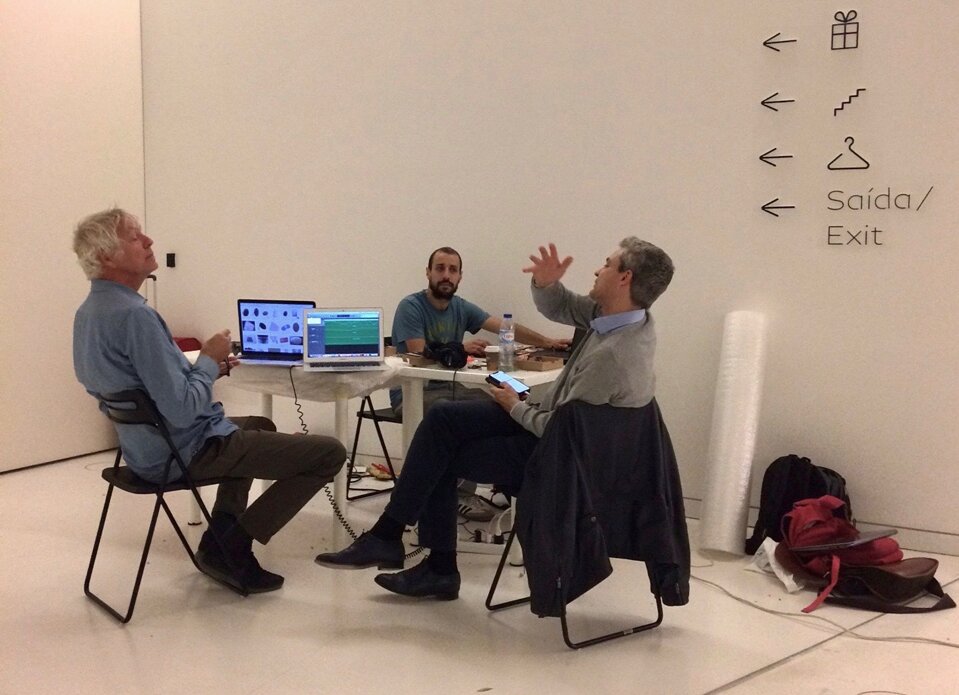
Discussing the project with Christophe and David
Discussing the project with Christophe and David
Jan did indeed bring a tree and a small rock that he had rented in a local garden shop, as well as a sculpture by himself, a miniature “communist sculpture” as he called it. “Frankie” he said, pointing at his work “this is the only real artwork in the whole room”. I nodded: “If you say so, Jan, I am glad to believe it!”. But in fact, the installation with the tree fitted nicely in the room. Some organic form and greenery in the middle of rather cold art and technology worked well, I thought.
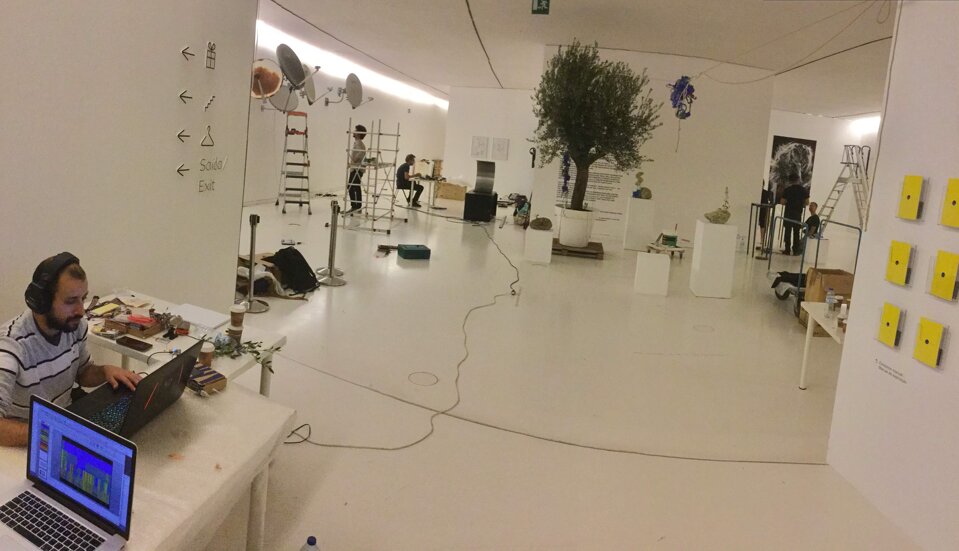
Setting up the exhibition “For a Brave New Brussels” at MAAT, Lisbon, with the tree, the rocks, the sculpture and David programming the Resistance Transistor.
At one moment Jan stood on a ladder banging a hole in the gypsum wall to attach a rope on which he hung unidentifiable rubbish painted in Klein blue. Probably a reference to what he thought the Resistance Transistor should eventually look like.
On the wall a text was already printed in large characters, a text that Jan and I had written “together”. But we hadn’t manage to produce something coherent. To make it somehow a bit comprehensible for those that made the effort to read it, I insisted that Jan’s contribution was written in capital letters and mine in small letters. Most of my contribution I already showed (see page 14 – 15, text in italics). Jan’s contribution included the following:
RT. - THE RESISTANCE (*) TRANSISTOR
LIVING APART TOGETHER WITH CLIMATE CHANGE
A DEVICE FOR “PUTTING IT TO WORK”. THE TIME IS RIPE BECAUSE WE NEED TO TAKE STOCK OF THINGS AND ARE CAPABLE TO TAKE STOCK OF THINGS!
THE – RT. –IS THE DEVICE , THE APPARATUS TO exchange essential information between humans and non-humans and LEARN GREAT MANY THINGS A NEW, and ACT.
…
THE RT. IS AN OLD DEVICE FOR MODERN COLLECTIVE (!) LEARNING.
THE RT. entangles the powerful hustle and bustle of todays humanity with the equally powerful grandness and slowness of nature, tuning into timescales of days, centuries and geologic era’s.
The RT. is about Deep Nature. IT WILL TEACH US MORE THAN ITS VICTORY BUT ITS CONSEQUENCES WILL FORCE THE OWNER OF THE RT. OR IN OTHER WORDS....THE “CARETAKER” OF THE RESISTANCE TRANSISTOR TO GO TO THE -BOTTOM OF NATURE LAWS
FOR AN EVEN STRONGER REASON:
THE RESISTANCE TRANSISTOR, IN ACCORDANCE WITH THE CONSTANT INFORMATION EXHANGED BETWEEN HUMANS, ROCKS AND TREES, WILL INFLUENCE AND INSPIRE ALL INDIVIDUAL HUMAN CARRIERS TO MAKE CONSTANT CRISES within the system creating crises. CREATE PROBLEMS TO FIND NEW ENERGY, TO RESIST THE DESTRUCTION OF OUR PLANET.
THE -R T. -FUNCTIONS ON THE BASIC CONCEPT- WHAT ABOUT YOU ? – DO YOU CARE? THE EXTREME OPPOSITE OF THE CONCEPT OF THE SELFIESTICK –WHAT ABOUT ME?
THE -R T.-IS A BENDABLE SOCIALSTICK TO EMBRACE MAN AND NATURE,
A REVOLUTIONAL “ACCESSOIRE” INVENTION NOT ONLY TO INTERPRET THE WORLD BUT ONE TO get deeply involved in it and CHANGE IT!!
IT’S ABOUT HUMANS BECOMING ALSO ROCK- AND TREE-LIKE, AND ROCKS AND TREES BECOMING ALSO HUMAN.
LET’S ROCK AND TREE.....
JAN DE COCK and FRANK RAES, AUGUST 2018 FROM STUDIO TORINO,IVREA
Yes, the text was signed by both Jan and myself. As soon as it appeared on the wall Jan became excited and for a full day he chased me to tell that people didn’t understand it anymore: that they thought he was the climatologist and I was he artist. I answered that this could only be fine: it showed that we were breaking down the wall between science and art, and was that not the purpose of our project? Jan could not agree. I enjoyed it. Every evening of the following days I would ask him what the weather of tomorrow would be.
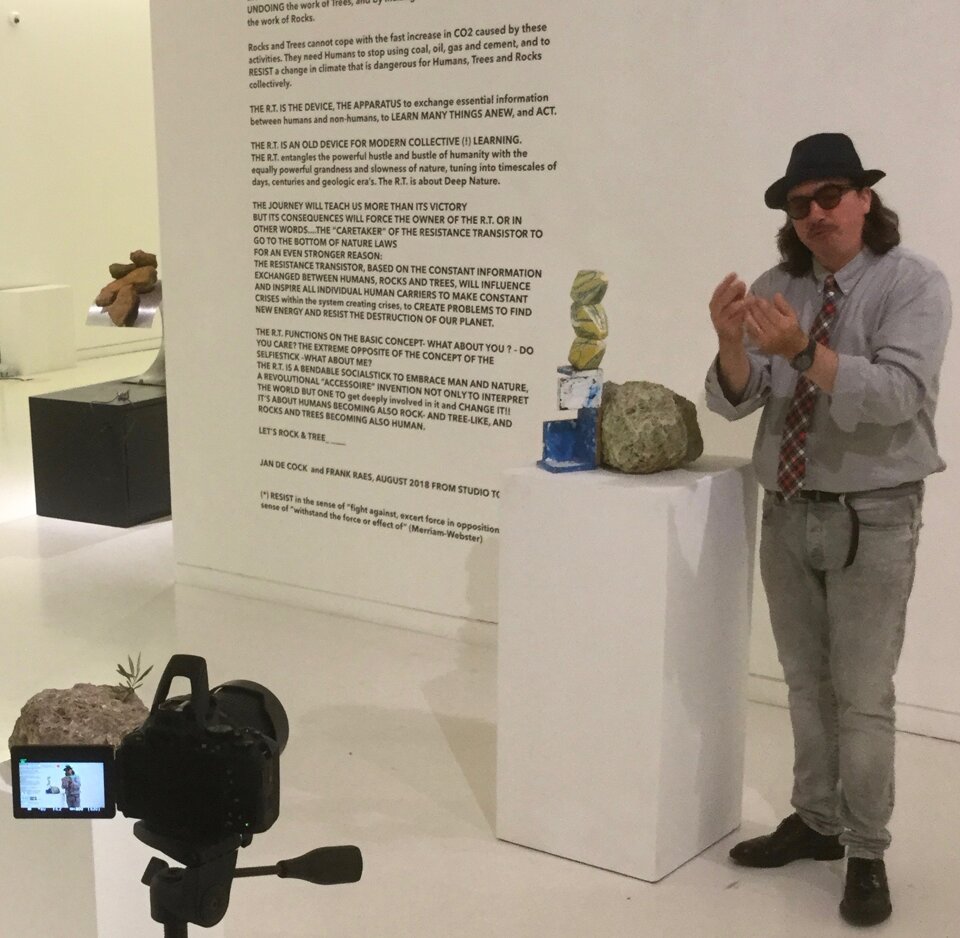
Jan explaining the installation.
Jan explaining the installation.
Similar to our scientific conferences, we would go for lunches and dinners and drinks deep into the night. We would escape from the exhibition in small groups to visit a special place: a museum of natural history, a popular restaurant or a weird neigbourhood. We would discuss, exchange experiences, make plans and … gossip.
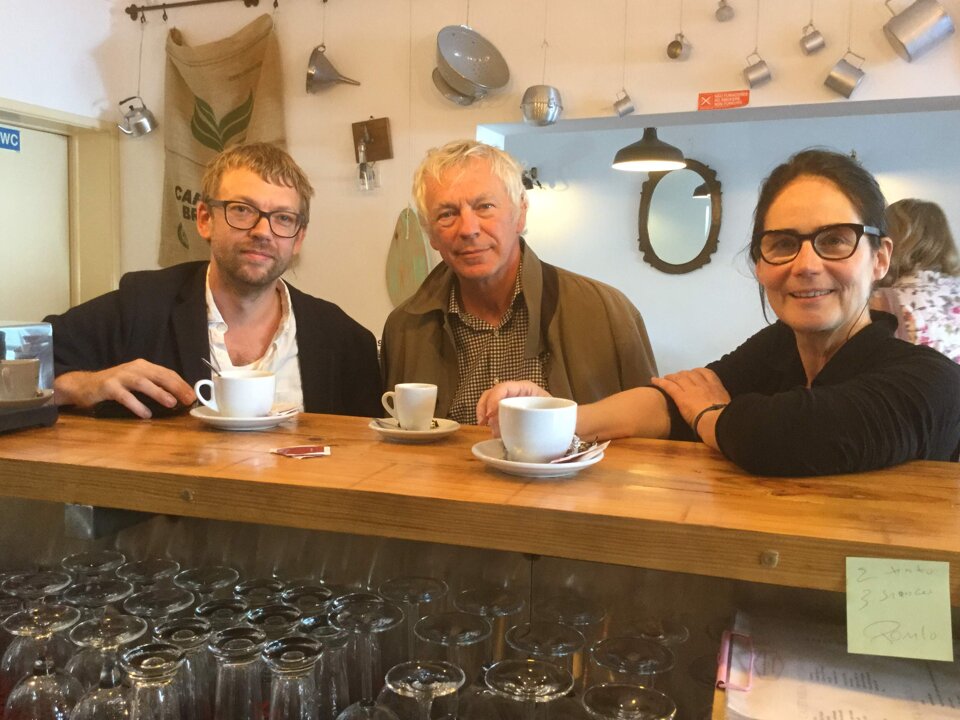
With Maarten Vanden Eynde and Annemarie Maes in a bar near the Natural History Museum.
With Maarten Vanden Eynde and Annemarie Maes in a bar near the Natural History Museum.
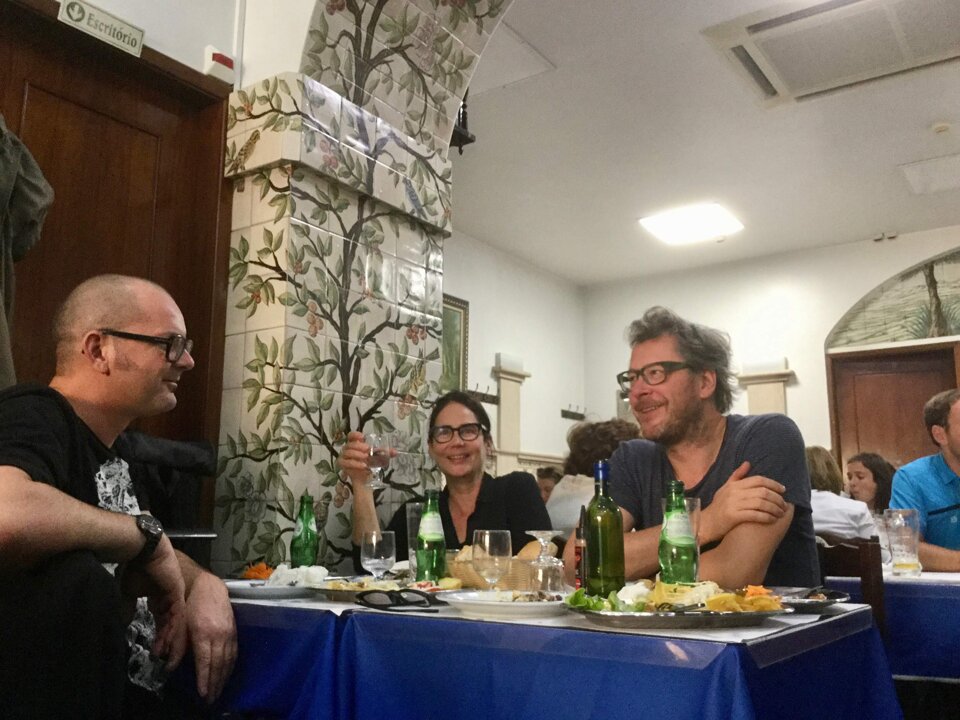
With Frederik De Wilde, Annemarie Maes and Christophe De Boeck in Restuarante "O Prado" near MAAT
With Frederik De Wilde, Annemarie Maes and Christophe De Boeck in Restuarante "O Prado" near MAAT
Different for both artists and scientists was that this time, probably because of the King, all dinners were for free. That allowed us to still go out in the city after dinner. And after having gone out, we would go out a second time and a third time. On such an early morning occasion, and probably because it was early morning, Christophe confessed: “Frank, you are naïve to believe that Jan has even the slightest interest in this project.” “Let me be naïve”, I answered, “at my age the challenge is not to stay young but to become a child again!” Of course Jan had his reasons for doing this project, and I could imagine a few of them, but I told Christoph that I was enjoying this project, and that at least I learned something about art and artists, and wasn’t that the whole purpose of his scientist in residence project: that a so called cold rational methodological scientist (a theoretical character!) could take something away from a warm, emotional and intuitive artist (and equally theoretical character!)? We clinked our plastic beakers of beer.
The only one who was never at the dinners was David, because he was the only one of the team who was working to get at least a minimal version of a Resistance Transistor. He worked only at night.

David in the cellar of MAAT, making and programming the Resistance Transistor RT!
David in the cellar of MAAT, making and programming the Resistance Transistor RT!
David is a whizz-kid. He built a kind of a smart phone from scratch with the same easiness as I would build a house in Lego bricks. He also programmed a first version of the game, including colours and music. It worked only if you were at a certain distance from the rock or from the tree or from Jan’s art work. It was an amazing and funny thing: it looked like a self-made bomb with a timer. And in fact, it caused us some problems when, one evening, we entered a restaurant with it.
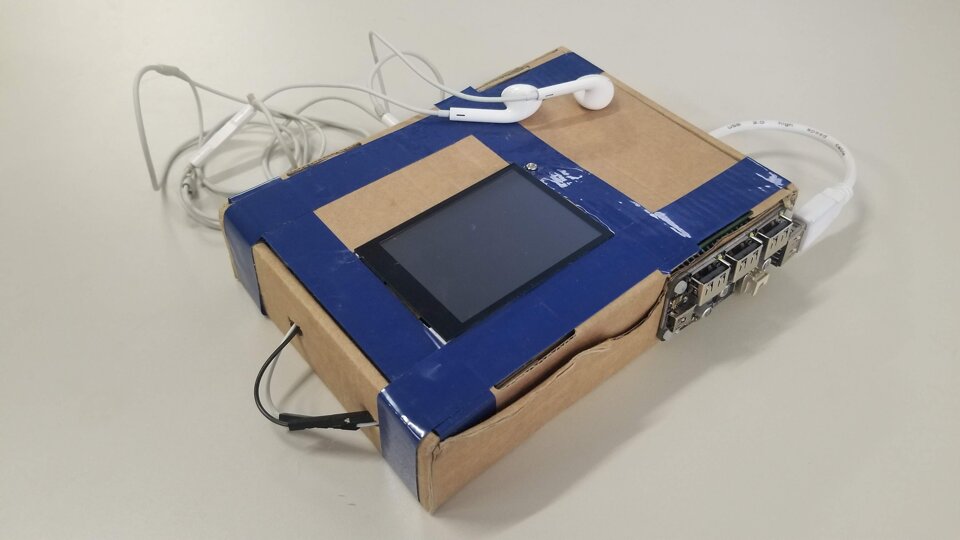
The one and only Resistance Transistor RT!
The one and only Resistance Transistor RT!
David was also around during daytime, wrapped in the smell of weed. “Nobody ever offered me a joint”, I confessed to David. “That’s not how it works”, he explained, ”it is like with women: they don’t come to you, you have to go to them.”. “But how can I know who to ask, about weed I mean?” “Well, you sort of recognize them and then you ask: do you have a long paper”. “A long paper?”, “Yes, a long cigarette paper, joints are rolled in long cigarette papers”. Is it that easy, I thought? Let’s try it. Frederik walked into the room and I asked with a low voice and in English: “Hi Fred, do you have a long paper?”. “You mean “een lang vlootje” (in dutch), of course!”. “No, no, thank you! I was just practicing something”. David was grinning.
Jan and I travelled back to Milano together. We talked about the project. He did not totally confirm what Christophe had told me. He was, yes, denigrating the discussions about climate and the environment: “Good for schoolkids” he said (* that was before Greta Thunberg stood up!). He was still thinking about an art work as a result of our discussions, but it would be something totally different than what we had been developing so far. Jan talked also bout the ups and downs of his artistic practice of the past years, about selling and not selling, the responsibility for his family, about living in Ivrea and sleeping with the windows open, something that was impossible in Brussels. We hugged each other on the parking lot of Malpensa and that had been the last time we saw each other
I wrote down my reflections about the Lisbon experience for Christophe.
“What we showed were elements of a narrative and elements of a final work. Jan rightly said that he was only offering “a scenography” for the moment, and that the final work, the final RT., would be totally different.I asked what he thinks should be retained from what we put together so far. He said it had been important to see the device David put together, so now he can think concretely about a design for the RT., i.e. work as the artist he is. He also understands the challenge to get data flowing in and out of the device (it is a full time job to make that work) and to create meaning/knowledge/form out of these data.
Jan is not very interested in building a device for awareness building about the environment. For him art is about something else. I follow him in this (although awareness building could still be an un-intended-but-hoped-for result of the work.)
Jan is clearly a bit uneasy about a number of things: the technological aspects, the group exhibition, having to develop something together with other people he cannot control. He cannot see what advantages this will bring for him. Rather he sees risks for his reputation. I think this is a fair concern for him. One thing that apparently interests him is to industrialize the RT.; it fits in his “sculpture communism”. He was in fact impatient about this and did not understand why David and I and GLUON kept saying that we were not there yet. As said before, I believe that he now understands a bit better the challenges (e.g. with technology, with data) to make some commercial product. At the end we have Jan saying on camera: “the idea is to make something that neither myself, neither David neither Frank can make on their own”. Isn’t that progress in the good direction of co-creation?
Re. David. He is a smart boy, fast programmer, etc. He has been very important to bring the project to where we are. I think his skills as a game developer are still under-used. I find it a fascinating idea to use the RT. as the device to enter something that can last 50 years, that is inter-generational. The way to achieve this might indeed be by gaming, collecting points, etc. (Makes me think of Catholic religion: you are born with a black soul, and your whole life is about doing good things and white-washing your soul).
The RT. should stay outside the mainstream technology of smartphones, etc. It should never be disposed of but be self-updating, both for what concerns soft-and hard-ware.
Re. myself. It should be clear that I am enjoying all of this. The project has many challenges: bringing disciplines together, bringing people together, … . We have been preaching about co-creation since years. I have done it involving science and policy making. Doing (doing!) it now with the arts is fantastic. I already shared my opinion that art, science and technology should all play an equal role in this project, and that something can emerge without one being in the lead.
It might not yet be clear where we are going. But there is a glimpse: the picture that Lise just sent. If you can capture the interest of children it proves that you are on the right way: if it works for children it works for adults!"
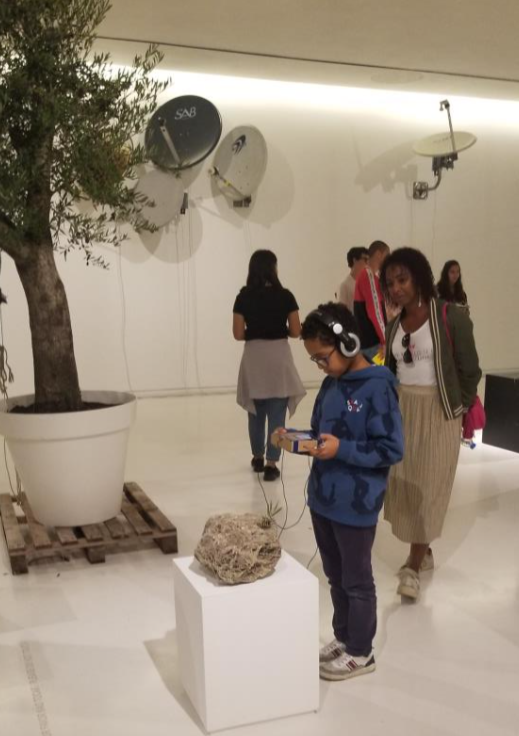
The picture of Lise: " If it works for children, it works for adults."
The picture of Lise: " If it works for children, it works for adults."
Christophe apparently read it and answered: “Beautiful Frank, and very to the point.”
Brussels November 2018
There was one further meeting in Brussels with David, GLUON and myself. We decided to go ahead with the App/game. A game to be played within an artistic installation that would be placed in a museum for a year. The app/game would run on the RT! device and a dedicated network that David would create outside the realms of Apple, Google, Samsung, Facebook, …. We would create a safe space for users to give information about themselves, their relationship with nature, etc.
We had a plan.
Before leaving the GLUON offices, I noticed Jan’s small communist sculpture in a corner of the room. It had travelled from Lisbon together with other stuff. Apparently, Jan had forgotten about it. Nobody at GLUON seemed to be interested so I could bring it to Italy for my Museum.
There was a further exchange of emails about how to make progress, about setting up a meeting about finding sponsors, …
In the mean time I worked on the game narrative and translated it in a flowchart, so that David could start programming.
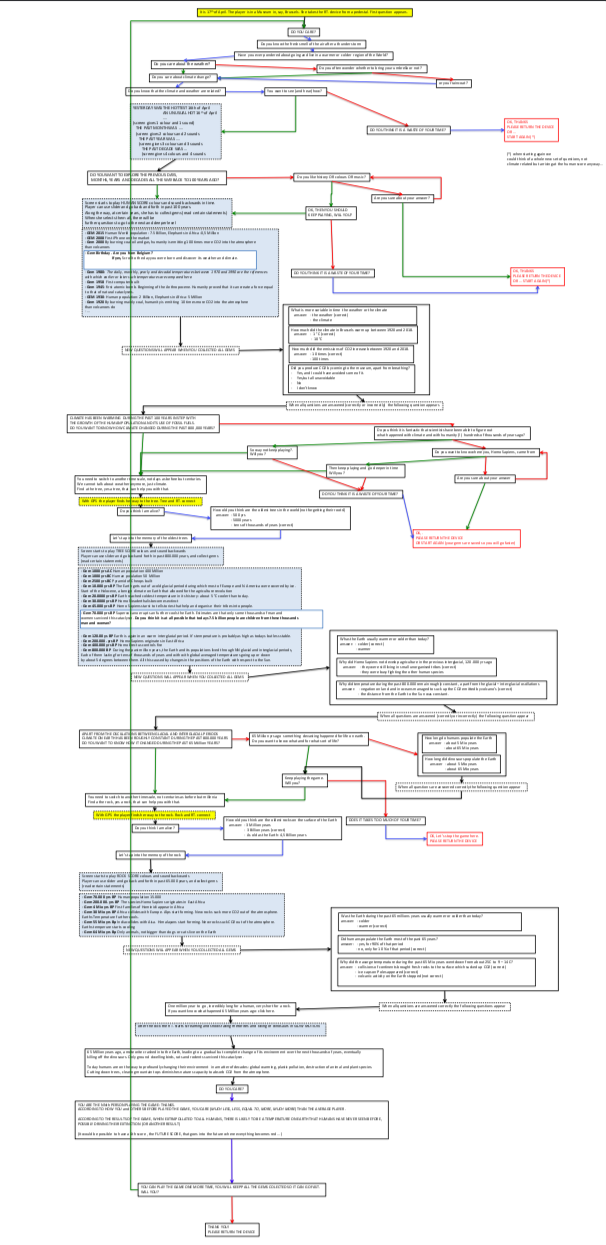
Flowchart of the narrative of the game to be programmed in the RT!
Flowchart of the narrative of the game to be programmed in the RT!
That was the last thing that had been done as part of the two years project. David had returned to Canada and Jan had become silent.
Months passed without news. I called Jan. I started telling him that my Museum now had one of his works. “On loan!” he said, and that is what I would write in the Museum’s catalogue. Jan further talked about the negotiations with GLUON and the contract. He talked about lawyers and so on. I said “Well, you guys figure it out: let me know.”
Vienna April 2019
Every year, all scientists who in one way or another study the Earth gather in Vienna for the European Geophysical Union meeting. For the first time they had also organized a session to discuss interactions between science and art. I thought it was a good occasion to take stock of our project. I submitted an abstract and eventually gave a presentation. The session itself showed the many ways in which artists and scientists tried to work together. There was obviously no single way or methodology for doing this. Everybody was experimenting. It was chaos from which, one day, a new way of approaching and studying our Earth could emerge. That’s what we hope and why we are doing all this.
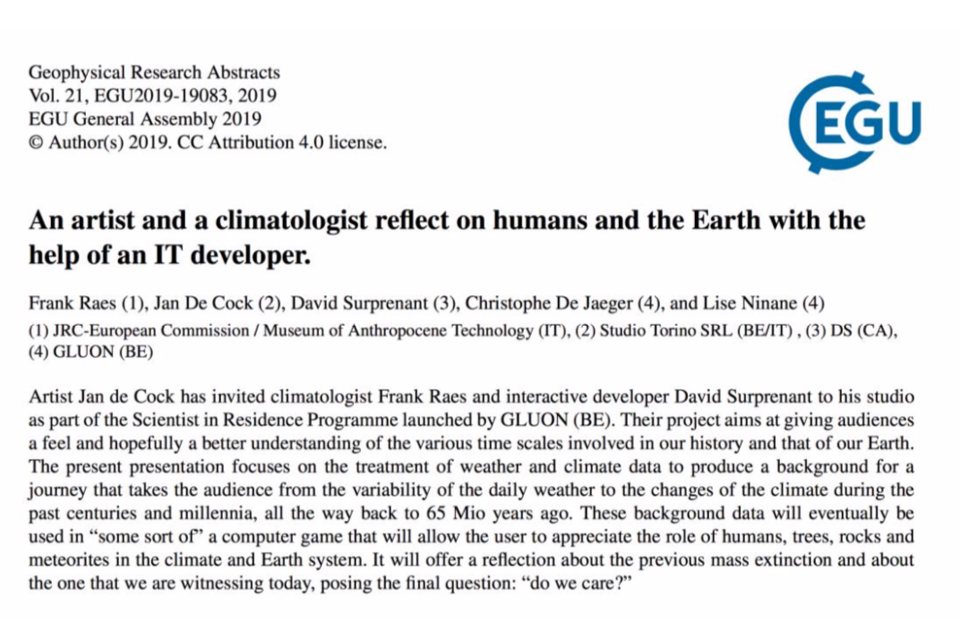
Abstract of the presentation of our project at the annual meeting of the European Geophysical Union
Abstract of the presentation of our project at the annual meeting of the European Geophysical Union
Linz Sept 2019
The project with Jan came to an end with a lot of loose ends: this is a nice way of saying that it actually had fizzled out. A panel discussion about SIRP was organized at Ars Electronica 2019. Jan wasn’t present. I reported on our collaboration by telling a short version of the story above.
In Linz I got to now Alexandra who hung out with the GLUON team. I vaguely recognized an accent in her voice. “I am from Harelbeke” she said. “Me too!”. She made a selfie and sent it to her best friend in Harelbeke who happened to be my niece (who then sent the picture to me again …).
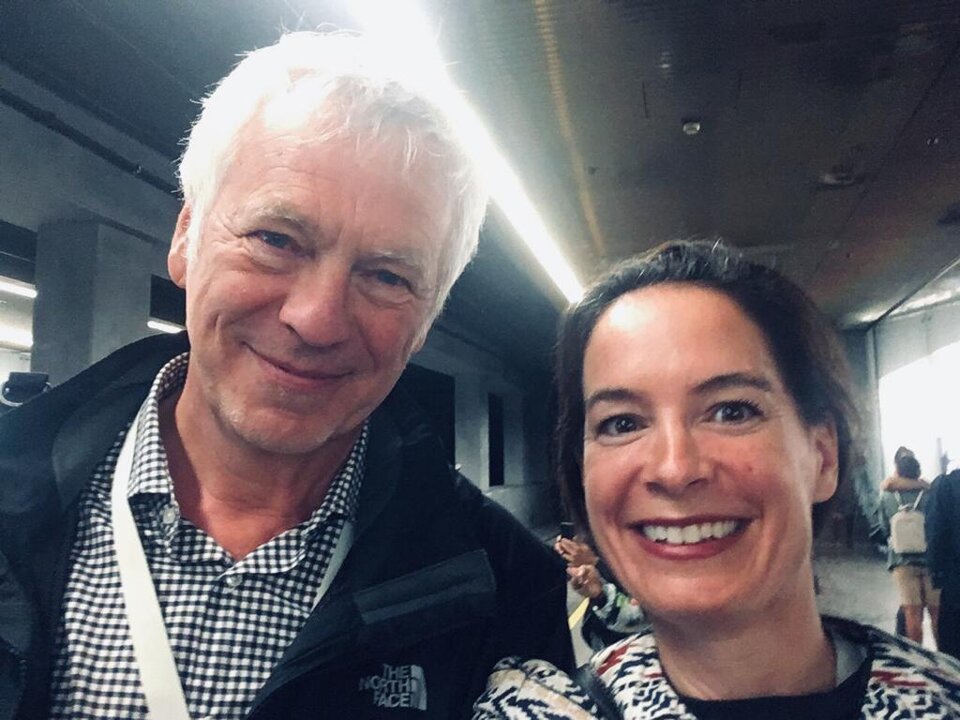
Alexandra’s selfie, down in the metro of Linz.
Alexandra’s selfie, down in the metro of Linz.
Alexandra and her partner had just created “Snowball”, an enterprise to get new and clean technologies rolling. I told about the App and she was interested. We would be in touch.
Harelbeke, of all places … January 2020
Months had passed. I wanted to call Jan for a long time, just to know how he was doing, how the works with the villa in Ivrea progressed. One day, I read a long interview with Jan in a Belgian magazine. It was about his new studio in … Brugge. Not Ivrea: Brugge! I called Jan. It was just like we had spoken the day before.
“Frankie where are you! I have to give a talk in a minute. What do I have to say?”
“Where are you?”
“In Harelbeke, at a workshop with Christophe and Alexandra, about science and art.”
In a flash I remembered something about this workshop on Facebook. I remembered things that Christophe had told.
”Harelbeke seems to be the centre of the world nowadays!” I said.
”Yes, I am here!”
”I spent my childhood there.”
”I know, that is why I am looking for you. But what do I have to tell? Right now there is a scientist talking who thinks he is an artist.”
”Well, don’t try to be a scientist. Not because you are not able: you are definitely as able to become a scientist as I am able to become an artist, but the point is that we don’t need to! Tell them that climate change is a real problem, but that artists will not solve it, scientists will not solve it, politicians will not solve it. We need a new kind of people with new sensitivities, with a new culture. We need a second renaissance. You can be a leading person in all this!”
Silence …, then: “Frankie, there is also an exhibition here and I tell you: the device that we made with David Canadian in Lisbon, that was more art than everything here together!”
“If you say so, Jan, I am glad to believe it!”
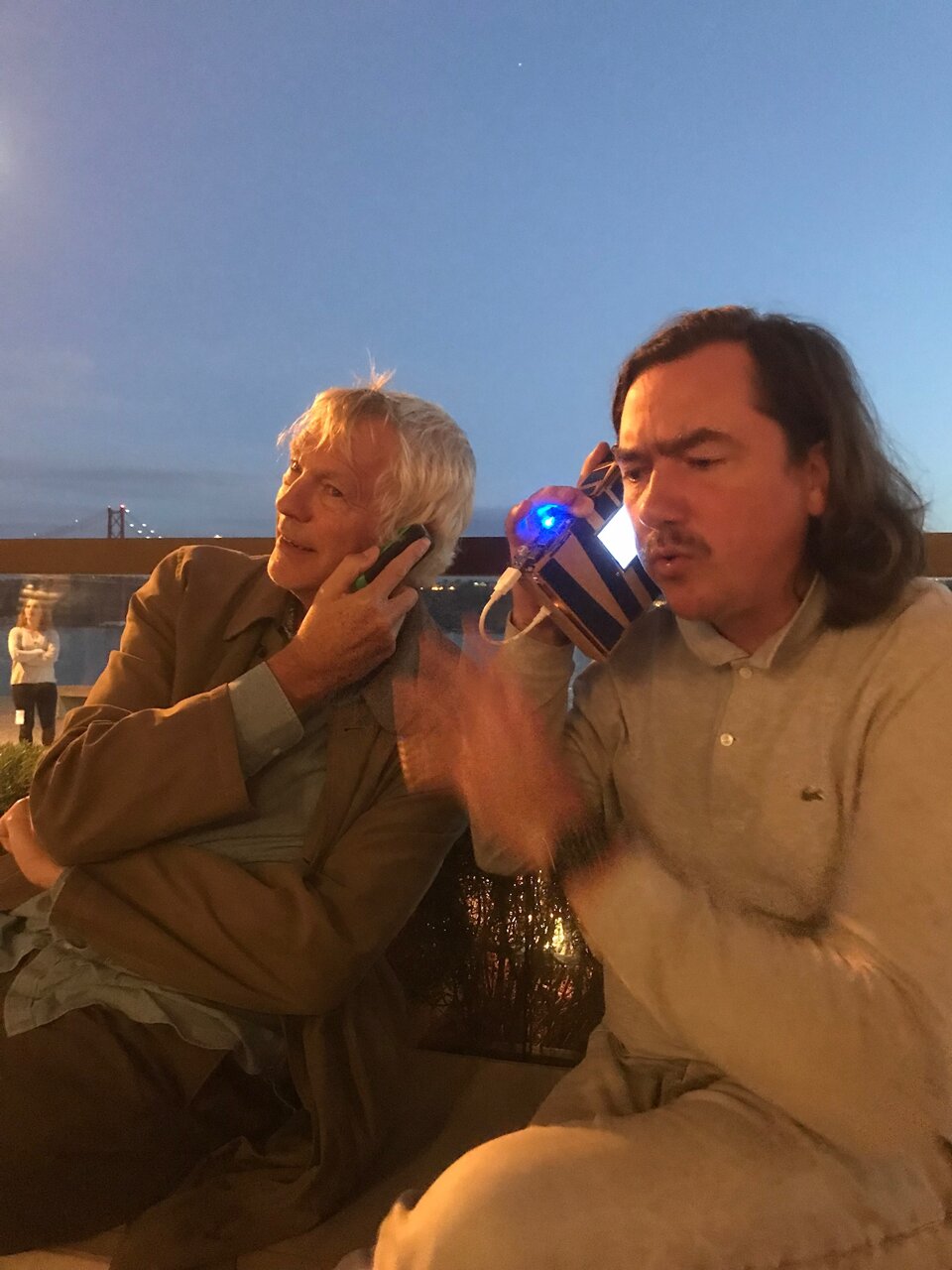
With Jan and the RT! It actually worked!
With Jan and the RT! It actually worked!
postmaster@museumofanthropocenetechnology.org, via Leggiuno 32
Laveno Mombello
21014
Italia